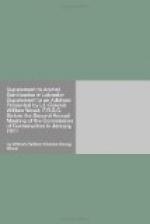I take the liberty of sending you a copy of an “interview” by the Montreal Witness upon my return in 1909, by which you will see that I am in accord with your views, i.e., unless the Government takes immediate steps to protect the wild animals in the Province of Quebec, many of them will become extinct....
I would suggest that the Commission of Conservation make a close investigation of the ways and means of the fur traders along the north shore, and I believe that official, unbiassed and independent investigation will expose a very peculiar state of affairs in connection with the mal-conservation of game.
Mr. Clive Phillips-Wolley, the well known authority on big-game sport, writes from Koksilah, Nanaimo, B.C., Canada:
... of course I agree with your views: we have in this Province been doing our best to put them in practice with the most excellent results. Dr. W.T. Hornaday stirred us up, and, though we did not put our sanctuaries exactly where he suggested we took a hint from him and have been rewarded by an extraordinary increase in big-horns, wapiti and other big game. I, of course, have shot a great deal as a big game hunter, but, thank God, I don’t remember one wanton kill, and I know I have not killed one per cent. of the beasts I might have done. No one wants to....
The Hon. Theodore Roosevelt, ex-President of the United States, writes:
I desire to extend my most earnest good wishes and congratulations to the Commission of Conservation of Canada. Your address on the need of animal sanctuaries in Labrador must appeal, it seems to me, to every civilized man. The great naturalist, Alfred Russell Wallace, in his book, “The World of Life,” recently published, says that all who profess religion, or sincerely believe in the Deity, the designer and maker of this world and of every living thing, as well as all lovers of Nature, should treat the wanton and brutal destruction of living things and of forests as among the first of forbidden sins. In his own words, “All the works of Nature, animate or inanimate, should be invested with a certain sanctity, to be used by us but not abused, and never to be recklessly destroyed or defaced. To pollute a spring or a river, to exterminate a bird or a beast, should be treated as moral offences and as social crimes. Never before has there been such widespread ravage of the earth’s surface by the destruction of vegetation, and with it, animal life, and such wholesale defacement of the earth. The nineteenth century saw the rise and development and culmination of these crimes against God and man. Let us hope that the twentieth century will see the rise of a truer religion, a purer Christianity.” I have condensed what Mr. Wallace said because it is too long to quote in full. He shows that this wanton and brutal defacement of Nature, this annihilation of the natural resources that should




